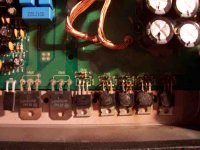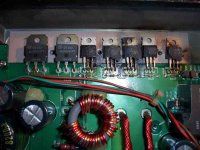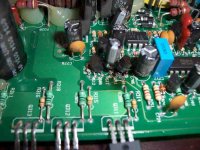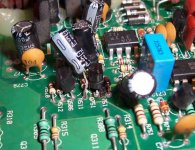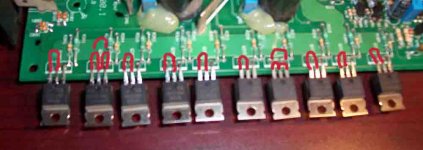i have never seen an amp with so many of these transistors. i am still unclear how to know what part to replace with when the component is a complete melt down.
is this normal for so many of these to die at once? i have 10 that are a totally destroyed. also should i be looking to replace the resistors along with the transistors? all the stripes are melted off but im sure i can asume they are all the same.
also i found other burnt components i think its a diode?
is there anything else i should be looking for? i havent even hooked power to this yet.
is this normal for so many of these to die at once? i have 10 that are a totally destroyed. also should i be looking to replace the resistors along with the transistors? all the stripes are melted off but im sure i can asume they are all the same.
also i found other burnt components i think its a diode?
is there anything else i should be looking for? i havent even hooked power to this yet.
Attachments
Burnt power supplies go hand in hand with shorted output Fets near those burnt resistors. A fairly common failure mode of just about ANY class D amp built in the past years gone by.
There was a fella on E-bay selling the JBL documents for this amp. I suggest you get them if your serious about repairing this amp.
If the output fets are not shorted I would start worrying about the Toroid transformer located near the burnt fets being shorted on itself.
All of the above have been seen inside these particular amps over the years... Good luck on your rebuild of the JBL
There was a fella on E-bay selling the JBL documents for this amp. I suggest you get them if your serious about repairing this amp.
If the output fets are not shorted I would start worrying about the Toroid transformer located near the burnt fets being shorted on itself.
All of the above have been seen inside these particular amps over the years... Good luck on your rebuild of the JBL
Q741/751 are the driver transistors for the power supply FETs (the burned ones). The part number is 2SA1266. You should replace both of them. D741/751 probably survived but you should replace them also. They are 1N4148 diodes.
You need to clean the area around all burned components. After cleaning, examine the areas that were blackened to determine if there is any damage to the board (especially around the driver transistor).
Before you order or replace anything, you need to check the outputs (previously suggested). If you read anything near 0 ohms between any of the legs of any individual transistor, the transistor is likely defective. Since the outputs are in parallel groups, if one is defective, all in that group must be replaced.
If one or more outputs have failed, there's a good chance that the audio driver transistors have failed. There's also a good chance that at least one of the 12v Zener diodes has failed (in the audio driver circuit).
You need to clean the area around all burned components. After cleaning, examine the areas that were blackened to determine if there is any damage to the board (especially around the driver transistor).
Before you order or replace anything, you need to check the outputs (previously suggested). If you read anything near 0 ohms between any of the legs of any individual transistor, the transistor is likely defective. Since the outputs are in parallel groups, if one is defective, all in that group must be replaced.
If one or more outputs have failed, there's a good chance that the audio driver transistors have failed. There's also a good chance that at least one of the 12v Zener diodes has failed (in the audio driver circuit).
i am measuring the resistors and they are all measuing around 7 ohms. are you sure that i should be ordering 22 ohm ones to replace them? (R742-r747) and (r752-r757). i found this part number from mouser but it is only 1/4 watt not the reccomended 1/5th watt
http://www.mouser.com/Search/ProductDetail.aspx?qs=9IB2bDhijq9XWQ3Mo17tIQ==
i found these to replace the burnt out power transistors. will they be the same for both sides of the amp
http://www.mouser.com/Search/ProductDetail.aspx?qs=V/rSMs4j2yNRAEnOvtUewg==
all of the biggest transistors (MUR304OPT) X4 all have continuity between all legs. i tested them in the board im not sure if i should pull to test or not.
as for the cluster of burnt parts at location. location Q751 is cracked and burnt ontop of the board and also underneath and im guessing Q506 is its twin? Q506 isnt cracked or burnt but should it be replced too? should i replace the capacitor at location R511 or the resistor underneath it? i cleaned it up and ill try post a better picture.
this part number isnt coming back from mouser as valid part number and mine is too melted to get a good number from.
where do i find these parts audio driver transistors or my zener diode on this board.
http://www.mouser.com/Search/ProductDetail.aspx?qs=9IB2bDhijq9XWQ3Mo17tIQ==
i found these to replace the burnt out power transistors. will they be the same for both sides of the amp
http://www.mouser.com/Search/ProductDetail.aspx?qs=V/rSMs4j2yNRAEnOvtUewg==
all of the biggest transistors (MUR304OPT) X4 all have continuity between all legs. i tested them in the board im not sure if i should pull to test or not.
as for the cluster of burnt parts at location. location Q751 is cracked and burnt ontop of the board and also underneath and im guessing Q506 is its twin? Q506 isnt cracked or burnt but should it be replced too? should i replace the capacitor at location R511 or the resistor underneath it? i cleaned it up and ill try post a better picture.
this part number isnt coming back from mouser as valid part number and mine is too melted to get a good number from.
where do i find these parts audio driver transistors or my zener diode on this board.
Attachments
scampo77 said:i am measuring the resistors and they are all measuing around 7 ohms. are you sure that i should be ordering 22 ohm ones to replace them? (R742-r747) and (r752-r757). i found this part number from mouser but it is only 1/4 watt not the reccomended 1/5th watt
742 and 752 are 1k ohm and 743-747 and 753-757 are 22ohm according to the service manual.
are the ouputs the transistors #MUR304OPT ?
"go hand in hand with shorted output Fets near those burnt resistors"
those transistors are right next to the burnt ones so i figured they would be it. i thought i just needed to check for resistance between all the legs? how else do i check them? the outer legs of all 4 measure at 0 ohms the others, when i apply the test leads they keep going higher and higher and all 4 respond the same way.
"go hand in hand with shorted output Fets near those burnt resistors"
those transistors are right next to the burnt ones so i figured they would be it. i thought i just needed to check for resistance between all the legs? how else do i check them? the outer legs of all 4 measure at 0 ohms the others, when i apply the test leads they keep going higher and higher and all 4 respond the same way.
The outputs are the IRF640s and IRF9640s.
The IRF3205s are the power supply FETs.
The 3040s are rectifiers. They rarely fail. You may need to pull them to check them. The outer legs are directly connected by traces on the board so it's normal for them to appear shorted. As long as the center leg isn't shorted to the outer legs, they're likely OK.
You can use 1/8 or 1/4 watt resistors. The 1/4 watt will have to stand up because they're too long to fit between the through-holes.
Q506 is the same part number as Q741 but they perform different functions. Q751 works with Q741 to drive the power supply FETs.
I would use the IRF3205s instead of the 75339s. Mouser has them as obsolete but they're not. Digikey has them.
You can get the 2SA1266s from MCM electronics.
The IRF3205s are the power supply FETs.
The 3040s are rectifiers. They rarely fail. You may need to pull them to check them. The outer legs are directly connected by traces on the board so it's normal for them to appear shorted. As long as the center leg isn't shorted to the outer legs, they're likely OK.
You can use 1/8 or 1/4 watt resistors. The 1/4 watt will have to stand up because they're too long to fit between the through-holes.
Q506 is the same part number as Q741 but they perform different functions. Q751 works with Q741 to drive the power supply FETs.
I would use the IRF3205s instead of the 75339s. Mouser has them as obsolete but they're not. Digikey has them.
You can get the 2SA1266s from MCM electronics.
The ones that have shorts between all 3 legs are shorted. The rest on this side of the amp's heatsink are probably not shorted but need to be replaced because they are part of a group of parallel transistors. If the ones on the other side of the heatsink show no signs of overheating and are not shorted, you don't need to replace them. If any of them look like the solder on the back of the transistors has melted (taken impression of insulator), I would replace them.
Pull the 2SA1023s and 2SC1027s on the side of the amp with the shorted transistors and check them carefully.
Pull the 2SA1023s and 2SC1027s on the side of the amp with the shorted transistors and check them carefully.
ok i have been reading and reseaching and i think i am almost ready to place an order. i only have a question about the last post what are the 2SA1023s and 2SC1027s? i have tried to find pictures and all i can find is that they are transistors but i cant find any components with those numbers on them
with the resistors that go along with the power supplies is this style of resistor still considered a surface mounted device? or does it have another name? how do i differentiate between the little square ones and the tubes with legs out of either end. can i use 1/10th watt transistors? i found some from MCM
http://www.mcmelectronics.com/product/16611220
i either have a choice between 1/10th watt and 1/14 watt and i figured if it means it is a smaller piece it might be easier to work with.
also someone mentioned to check the zener diode and the torrid transformer. what are these and where do i find them?
i have also found another cracked transistor next to the driver transistors. it looks to be the same part it is in the picture i put up. it is the transistor on the bottom right hand corner of the picture.
i will only be replacing the outputs on one side of the board. (4x f640 and 6x f9640)
with the resistors that go along with the power supplies is this style of resistor still considered a surface mounted device? or does it have another name? how do i differentiate between the little square ones and the tubes with legs out of either end. can i use 1/10th watt transistors? i found some from MCM
http://www.mcmelectronics.com/product/16611220
i either have a choice between 1/10th watt and 1/14 watt and i figured if it means it is a smaller piece it might be easier to work with.
also someone mentioned to check the zener diode and the torrid transformer. what are these and where do i find them?
i have also found another cracked transistor next to the driver transistors. it looks to be the same part it is in the picture i put up. it is the transistor on the bottom right hand corner of the picture.
i will only be replacing the outputs on one side of the board. (4x f640 and 6x f9640)
Q202-205 and Q302-305 are 1023s and 1027s. Check the ones on the side with the shorted outputs.
The MCM resistor is a chip (SMD) resistor, you need a through-hole, leaded resistor.
The Zener is a 1N5242.
The toroidal power transformer is the large donut wrapped with wire. If you have shorted outputs, the transformer is likely OK. When you have a blown power supply and no reason for it to blow (like shrted output), you would suspect that you may have a shorted power transformer.
The MCM resistor is a chip (SMD) resistor, you need a through-hole, leaded resistor.
The Zener is a 1N5242.
The toroidal power transformer is the large donut wrapped with wire. If you have shorted outputs, the transformer is likely OK. When you have a blown power supply and no reason for it to blow (like shrted output), you would suspect that you may have a shorted power transformer.
those transistors 1023 and 1027 seem to have continuity only on one leg and non of them seem to be burnt or cracked. actually all of them still have dust on them. so hopefully this means they are fine.
the torridial transformer doesnt seem to be burnt or ugly anywhere, but i havent pulled it out.
should i replace the zener diodes? i cant find anything that looks like a diode that is burnt. and according to mcm electronics that number you gave me is discontinued.
is it alright that i use the 1/10 watt through hole resistors? i only want to use them because they are smaller phsical size.
the torridial transformer doesnt seem to be burnt or ugly anywhere, but i havent pulled it out.
should i replace the zener diodes? i cant find anything that looks like a diode that is burnt. and according to mcm electronics that number you gave me is discontinued.
is it alright that i use the 1/10 watt through hole resistors? i only want to use them because they are smaller phsical size.
You need to pull all of the 1023,/1027 transistors near the outputs that failed and check them out of the circuit. Sometimes one of a parallel pair will open which will make the amp less reliable.
I'm not sure what you mean by 'continuity' but on diode check, you should read ~0.6v from base to emitter and base to collector and open on all other combinations. If you read 0.6v from base to only one leg, the transistors are defective.
You can't really check the power transformer with a multimeter (except to check for a short between primary and secondary which isn't likely to be a problem here). When they fail, they rarely show it. Don't pull the transformer. They are generally very difficult to get back in due to the short legs.
Diodes and transistors RARELY have visible signs of damage in the audio circuit. The Zeners are sometimes difficult to check. The only sign that they're defective is a low breakdown voltage. They don't always show leakage (electrical) and are rarely shorted when defective (in these amps). After powering up the amp, you would measure the voltage across the diode to make sure it's 12v ±5%.
Most of the resistors that are the size of the original 22 ohm resistors are rated at either 1/6w or 1/8w. The 1/10w that you found is a surface mount device and therefore has no wire leads to go through the board.
I'm not sure what you mean by 'continuity' but on diode check, you should read ~0.6v from base to emitter and base to collector and open on all other combinations. If you read 0.6v from base to only one leg, the transistors are defective.
You can't really check the power transformer with a multimeter (except to check for a short between primary and secondary which isn't likely to be a problem here). When they fail, they rarely show it. Don't pull the transformer. They are generally very difficult to get back in due to the short legs.
Diodes and transistors RARELY have visible signs of damage in the audio circuit. The Zeners are sometimes difficult to check. The only sign that they're defective is a low breakdown voltage. They don't always show leakage (electrical) and are rarely shorted when defective (in these amps). After powering up the amp, you would measure the voltage across the diode to make sure it's 12v ±5%.
Most of the resistors that are the size of the original 22 ohm resistors are rated at either 1/6w or 1/8w. The 1/10w that you found is a surface mount device and therefore has no wire leads to go through the board.
should i just replace the 1023/1027 ? to be on the safe side? is it normal practice to pull them out and put them back in? i would think just change them with new ones.
the 2SC1027 are 11$ each is that right? and they are coming up as discontinued part from MCM.
The Zener # 1N5242 is coming up as a discontinued part number according to MCM electronics. is there a different number i can use in place it? does anyone have a location for it on this amp im still not sure what im looking for.
i thought continuity was something used for diagnosing things like this. i have a beeping diode test on my multimeter and i love it i try to use it for everything . when it beeps it means something is god/bad LOL. i will start posting with resistence i find instead of continuity.
the 2SC1027 are 11$ each is that right? and they are coming up as discontinued part from MCM.
The Zener # 1N5242 is coming up as a discontinued part number according to MCM electronics. is there a different number i can use in place it? does anyone have a location for it on this amp im still not sure what im looking for.
i thought continuity was something used for diagnosing things like this. i have a beeping diode test on my multimeter and i love it i try to use it for everything . when it beeps it means something is god/bad LOL. i will start posting with resistence i find instead of continuity.
- Status
- This old topic is closed. If you want to reopen this topic, contact a moderator using the "Report Post" button.
- Home
- General Interest
- Car Audio
- Jbl Bp1200
